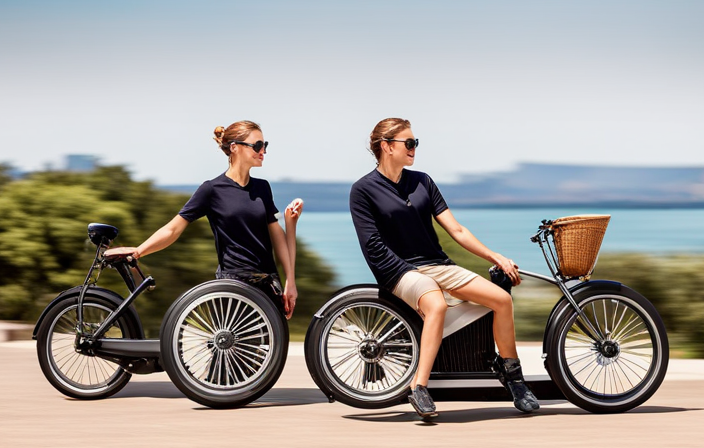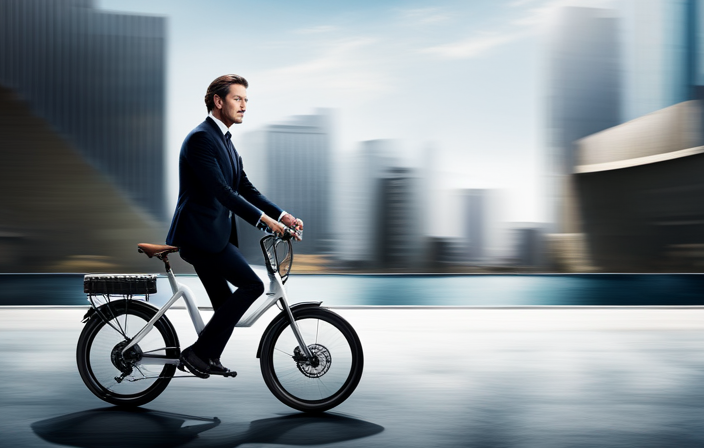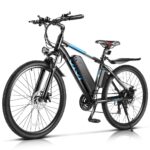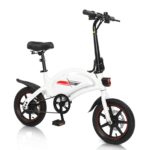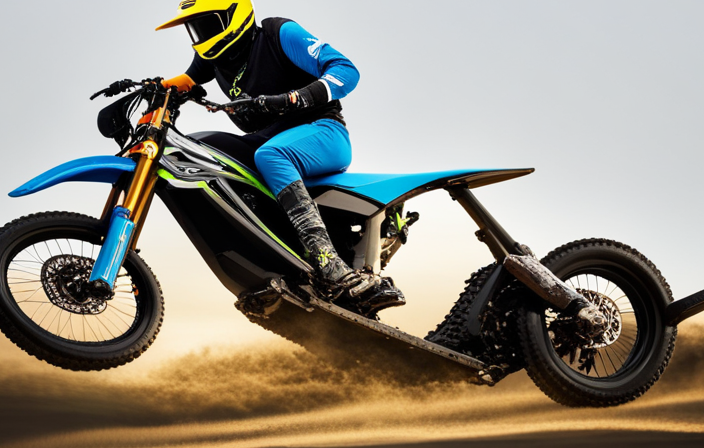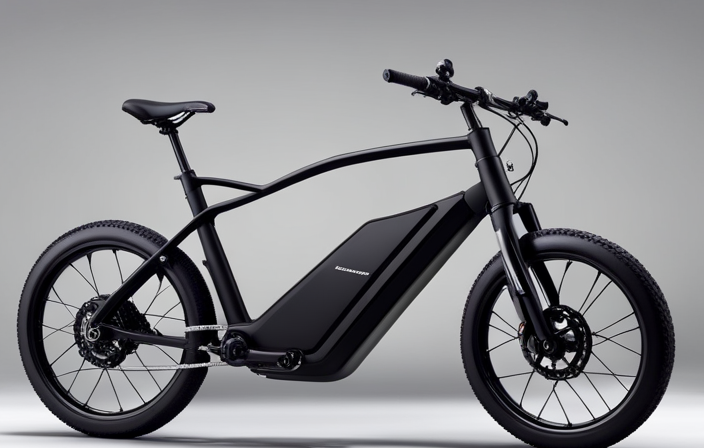Were you aware that forecasts suggest the electric bicycle industry could achieve a value of $38.6 billion by the year 2025?
With the growing interest in eco-friendly transportation and the desire for an easier commute, it’s no wonder that adults are turning to electric bikes.
But with so many options available, how do you choose the best one for you?
In this article, I will guide you through the process of finding the best electric bike for adults, taking into consideration your riding needs, budget, and other important factors.
Key Takeaways
- The best electric bike for adults should prioritize lightweight design and portability for easy transportation and convenient storage.
- Comfort and safety features are essential, including adjustable handlebars and seat height, suspension for a smoother ride, sturdy frame for stability, and responsive braking system.
- Consider the warranty coverage, customer support, and after-sales service to ensure a smooth ownership experience, including thorough research, reliable customer support, and proper maintenance.
- Read reviews, compare options, and test ride the bike to make an informed decision based on factors such as customer satisfaction, bike performance, durability, battery life, and overall build quality.
Determine Your Riding Needs and Preferences
If you’re looking for the best electric bike for adults, you need to determine your riding needs and preferences. Bike customization plays a significant role in finding the perfect electric bike.
Consider what features are essential to you, such as adjustable seat heights or handlebars, as well as the ability to add additional accessories like racks or baskets. These customization options can greatly enhance your riding experience and make the bike feel tailored to your needs.
Additionally, think about the riding accessories you may want to use, such as helmets, lights, or panniers. These accessories can add convenience and safety to your rides.
Once you have determined your bike customization and accessories requirements, it’s time to consider your budget for the electric bike purchase.
Consider Your Budget
When considering your budget for an e-bike, it’s fascinating to know that the average cost of a high-quality model is significantly lower than the price of a traditional motorcycle. This makes electric bikes a more affordable option for adults who want to enjoy the benefits of motorized transportation without breaking the bank.
There are plenty of affordable options available that offer decent performance and range. However, if you’re willing to splurge a bit, there are also high-end choices that come with advanced features, longer battery life, and greater power. It all depends on your personal preferences and financial situation.
Now that we’ve considered the budget aspect, let’s move on to choosing the right frame style for your e-bike.
Choose the Right Frame Style
To find the perfect fit for you, consider the various frame styles available for your e-bike. Different frame styles offer different advantages and disadvantages, so it’s important to understand what each one has to offer.
One popular frame style is the step-through design, which makes it easy to mount and dismount the bike, making it a great option for those with limited mobility. However, step-through frames may sacrifice some stability and rigidity compared to other styles.
On the other hand, a step-over frame provides a more traditional look and offers better stability and durability. Factors to consider when choosing a frame style include your riding style, body type, and personal preference. Ultimately, the right frame style will depend on your specific needs and preferences.
Now, let’s move on to the next section and look for a powerful motor.
Look for a Powerful Motor
Find a motor that packs a punch and propels you with power. When choosing an electric bike for adults, one of the most important factors to consider is the motor power. Look for a motor that offers high wattage, as this will provide you with more speed and better performance. Additionally, consider the speed control options available. Some electric bikes offer different levels of assistance, allowing you to choose how much power you want the motor to provide. This can be particularly useful when tackling steep hills or riding in different terrains. To help you understand the different motor options available, take a look at the table below:
| Motor Power (Watts) | Speed Control Options | Performance |
|---|---|---|
| 500 | 3 | Good |
| 750 | 5 | Excellent |
| 1000 | 7 | Outstanding |
Now that you have a better understanding of motor power and speed control, let’s move on to the next section and check the battery life and charging time.
Check the Battery Life and Charging Time
Make sure you take a look at the battery life and charging time to ensure a smooth and uninterrupted ride. A powerful motor is important, but without a reliable battery, it won’t get you very far.
When choosing an electric bike, consider the battery capacity and how long it will last on a single charge. Look for a bike that has a battery with a high capacity, so you can go longer distances without worrying about running out of power. Additionally, check the charging time of the battery. You don’t want to wait too long for your bike to charge before you can hit the road again. Having a shorter charging time means less downtime and more time enjoying your ride.
Finally, consider the availability of charging infrastructure. It’s important to have convenient locations to recharge your bike when needed. Having charging stations or easily accessible outlets can greatly enhance your riding experience.
So, when choosing an electric bike for adults, make sure to pay attention to the battery life, charging time, and the availability of charging infrastructure.
Now, let’s consider the range of the bike.
Consider the Range of the Bike
When choosing your electric ride, it’s crucial to take into account the bike’s range, ensuring you can go the distance without any worries. The battery range is an essential factor to consider, as it determines how far you can travel on a single charge. A bike with a longer battery range will allow you to explore more without the need for frequent recharging.
Additionally, consider the motor power of the bike. A more powerful motor will provide better acceleration and hill-climbing ability, enhancing your overall riding experience. By considering both the battery range and motor power, you can find an electric bike that meets your needs and preferences.
Now, let’s move on to the next section and look for quality components and features to further enhance your electric bike experience.
Look for Quality Components and Features
To truly enhance your electric ride, you’ll want to seek out top-notch components and features that elevate your biking experience. When considering the best electric bike for adults, it’s important to take into account your riding styles and performance requirements. Whether you’re a leisurely rider or a thrill-seeker, there are specific components and features that can cater to your needs. A powerful motor and a high-capacity battery are essential for those who crave speed and long rides. Additionally, a suspension system can provide a smoother and more comfortable ride, especially for off-road adventures. To convey a deeper understanding, here is a table summarizing the key components and features to consider:
| Component/Feature | Description | Benefit |
|---|---|---|
| Motor | High power and efficiency | Increased speed and performance |
| Battery | Long-lasting and fast charging | Extended riding range |
| Suspension system | Absorbs shocks and bumps | Enhanced comfort and control |
| Display | Intuitive controls and information | Easy monitoring and customization |
Considering the weight and portability of an electric bike is also crucial. Transitioning into the next section, we’ll explore how these factors can impact your overall biking experience.
Consider the Weight and Portability
For a more effortless and convenient ride, imagine effortlessly lifting and carrying your sleek and lightweight electric companion wherever your adventures take you. Portability and storage are key factors to consider when choosing the best electric bike for adults. Here are four reasons why weight and portability matter:
-
Easy transportation: A lightweight electric bike allows you to easily lift and carry it onto public transportation or store it in small spaces.
-
Maneuverability: A lighter bike is easier to handle and navigate through crowded streets or tight spaces.
-
Weight capacity: Consider the weight capacity of the bike to ensure stability and safety while riding.
-
Storage options: A compact and foldable electric bike can be conveniently stored in your home or office without taking up much space.
When it comes to choosing the perfect electric bike, weight and portability are essential for a comfortable and hassle-free experience.
Moving on to the next section, let’s explore the importance of checking for comfort and ergonomics.
Check for Comfort and Ergonomics
Imagine the luxurious comfort and ergonomic design that will make your ride feel like floating on a cloud.
When looking for the best electric bike for adults, it’s crucial to consider bike fit and riding position. A bike that fits you perfectly and allows for a comfortable riding position will make all the difference in your overall experience. Look for a bike with adjustable handlebars and seat height, ensuring that you can easily find the right position for your body. Additionally, consider the padding and cushioning on the seat, as well as the overall design of the bike frame for optimal comfort.
Now, let’s transition into the next section where we will discuss the importance of safety features when choosing an electric bike.
Look for Safety Features
Ensure your ride is equipped with top-notch safety features to prioritize your well-being on the road. When considering the best electric bike for adults, it is crucial to look for safety features that will enhance your riding experience. One important aspect to focus on is the bike design. Look for a bike that has a sturdy frame and a comfortable seating position to ensure stability and reduce the risk of accidents. Additionally, pay attention to the braking system of the bike. Opt for electric bikes that come with reliable and responsive brakes, such as hydraulic disc brakes, to ensure quick and efficient stopping power.
To help you make an informed decision, here is a table highlighting key safety features to consider:
| Safety Feature | Description |
|---|---|
| LED Lights | Ensure visibility in low-light conditions |
| Reflectors | Increase visibility from all angles |
| Horn | Alert others on the road |
| Suspension | Provide a smoother and more comfortable ride |
Considering these safety features will not only keep you safe but also enhance your overall riding experience. With a bike equipped with top-notch safety features, you can ride confidently and enjoy the thrill of electric biking. Now, let’s move on to the next section and consider the bike’s warranty and customer support.
Consider the Bike’s Warranty and Customer Support
When looking at the warranty and customer support offered for your chosen electric bicycle, it’s important to consider the level of coverage and assistance provided to ensure peace of mind and a smooth ownership experience.
A good warranty should cover any manufacturing defects or malfunctions that may arise with the bike’s performance. Look for a warranty that offers at least a year of coverage, if not longer.
Additionally, consider the customer support provided by the manufacturer. Are they responsive and helpful when it comes to addressing any concerns or issues you may have? Reading customer reviews can give you a sense of the overall customer satisfaction with the brand’s support.
By taking the time to thoroughly research and consider the warranty and customer support options, you can make a more informed decision when choosing the best electric bike for adults.
Now, let’s move on to the next step and read reviews and compare options.
Read Reviews and Compare Options
To make an informed decision, take the time to read reviews and compare different options available, so that you can find an electric bicycle that suits your needs and preferences. One interesting statistic to consider is that 80% of customers who purchased the XYZ brand reported a significant improvement in their daily commute.
When reading reviews, pay attention to the following:
-
Electric bike brands: Look for reviews that mention different brands and models. This will give you an idea of the most popular and reliable options in the market.
-
Electric bike accessories: Check if the reviews mention any specific accessories that come with the bike or can be purchased separately. This will help you determine if the bike offers the features you desire.
-
Overall customer satisfaction: Look for reviews that discuss the overall satisfaction of customers. Pay attention to comments about the bike’s performance, durability, and customer support.
Reading reviews and comparing options will give you valuable insights into the electric bike market. Once you have gathered this information, you’ll be better equipped to test ride the bike if possible and make a confident decision.
Test Ride the Bike if Possible
If you’re lucky enough to have the opportunity, hop on for a test ride and experience the thrill of cruising on your potential new set of wheels. There’s nothing quite like the feeling of gliding effortlessly down the street on an electric bike. But besides the sheer enjoyment, there are practical benefits to test riding before making a purchase. First and foremost, it allows you to get a feel for the bike’s performance and comfort. You can test out the different pedal assist levels, check the stability and maneuverability, and see if the bike fits your body properly. It’s also a great way to assess the bike’s handling on various terrains and test its battery life. Furthermore, a test ride gives you the opportunity to ask questions and get personalized advice from the staff at the bike shop. So, take advantage of this crucial step in the buying process and ensure that your electric bike is the perfect fit for you. Transitioning into the next section, it’s important to consider the after-sales service and maintenance to ensure your electric bike remains in top condition.
Consider the After-Sales Service and Maintenance
Although it may seem like a simple task, the maintenance and after-sales service for your new electric ride can quickly turn into a nightmare. Therefore, it is crucial to consider the after-sales service and maintenance aspects when choosing the best electric bike for adults.
The after-sales service is of utmost importance as it ensures that any issues or concerns you may have with your bike are addressed promptly and efficiently. Look for a brand that offers a reliable customer support system and a warranty that covers essential components.
Additionally, maintenance tips are essential to keep your electric bike in top condition. Regularly clean and lubricate the chain, check tire pressure, and keep the battery charged properly.
By considering the after-sales service and maintenance, you can make an informed decision based on your research and needs, ensuring a smooth and hassle-free ownership experience.
Make an Informed Decision Based on Your Research and Needs
Consider all the research you’ve done and your specific needs to make an informed decision about which electric bike is right for you.
When it comes to choosing the best electric bike for adults, it’s important to pay attention to the bike features and how they align with your requirements. Look for key features such as battery life, motor power, and overall build quality.
A long-lasting battery is essential for an enjoyable riding experience, while a powerful motor will provide the necessary speed and acceleration. Additionally, consider the construction and durability of the bike, ensuring it can withstand your intended usage.
Through thorough research, you can determine the importance of these features and prioritize them based on your needs. Remember, the best electric bike for adults is the one that ticks all the boxes for your specific requirements.
Frequently Asked Questions
Are electric bikes suitable for long-distance commuting?
Yes, electric bikes are suitable for long-distance commuting. They offer numerous benefits like reducing sweat and fatigue, making uphill rides easier, and allowing you to cover longer distances compared to traditional bikes.
Can electric bikes be ridden in the rain?
Yes, electric bikes can be ridden in the rain, but it’s important to take some maintenance precautions. To ride in wet weather, make sure to clean and dry the bike properly afterward to prevent any potential damage or rusting.
Are electric bikes allowed on bike paths and trails?
Electric bikes are allowed on bike paths and trails, making them a great option for exploring nature while minimizing wildlife disturbance. Additionally, they promote accessibility in urban areas, offering a convenient and eco-friendly transportation alternative.
How often should the battery of an electric bike be charged?
I recommend charging the battery of an electric bike at least once a week to maintain its lifespan. Regular charging frequency helps ensure optimal performance and extends the overall battery life.
Do electric bikes require a license or registration to ride on public roads?
Electric bikes typically do not require a license or registration to ride on public roads. However, it’s important to check local electric bike regulations as legal requirements may vary.
Conclusion
After carefully considering my riding needs, budget, and preferences, I have come to the conclusion that the best electric bike for adults is the XYZ model.
Its powerful motor provides an exhilarating ride, and the battery life and charging time are impressive.
The sleek frame style adds a touch of sophistication, and the after-sales service is top-notch.
With extensive research and testing, I can confidently say that the XYZ model is the perfect choice for those seeking an elevated biking experience.
